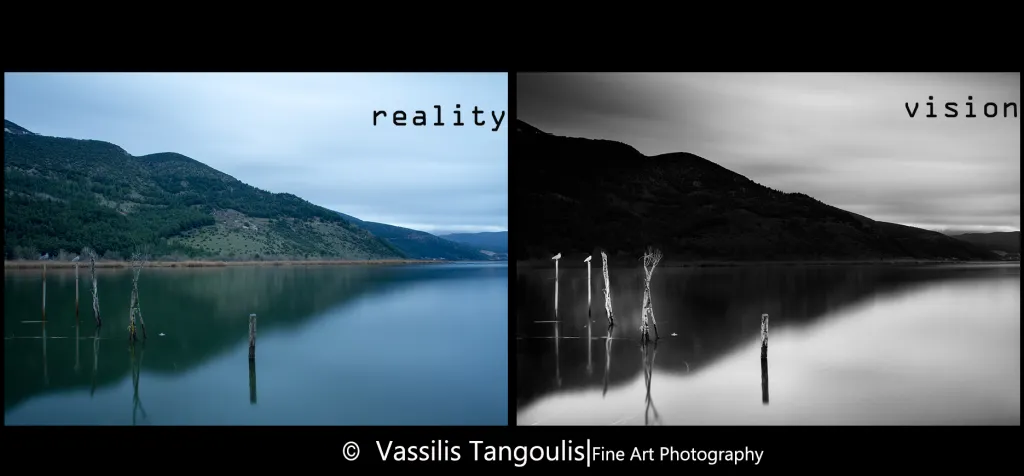The origin
When i try to describe my vision is like i draw incoherent lines, shapes in a white paper without any real meaning and sense mostly because everything is driven by emotion and, for me at least, is very difficult to “tame” it and restrict it in regular shapes and rules. I am surprised when i read about the visions of other photographers so well defined and described. It is like you can control your emotions or leave them out of the whole creativity process. Anyway lately i was featured in a new photomagazine and was asked to give my ideas about the terms Clarity and Confusion and how these terms define my work. It was that time i realized that these terms could describe quite well my whole perception about my Fine Art Photography. I will try to elaborate this but firstly i will show two of my latest artworks from my collection “Borders”. It is the best way to describe the way i work and understand Fine Art.
My “real” world is unreal
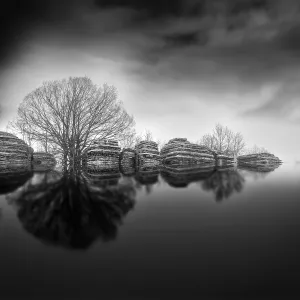
“Borders” collection
© Vassilis Tangoulis| Fine Art Photography
These latest artworks show clearly that I am motivated by a vision to transform the “real world” out there into a dreamy place possibly in another timeframe and outside the ordinary description of shapes, lines and figures. In order to succeed this I am using the Long exposure technique allowing me to play with large time exposures and my post processing skills. The truth is that beyond every photographic technique and any post processing skill i have to visualize these unearthly scenes, i have to “see” these rock formations and the trees balancing in the borders of a calm sea and a dynamic sky.
As i have said I am drawn to Long exposure photography because it allows me to add a fourth dimension– i.e. time– to a three dimensional object. My photography is a 4D object leaving its footprint, its “trace,” in a 2D layer. When this happens for a 3D object, it is easy for a mind to visualize its 3D morphology. In order to envision a 4D object, however, one needs the power of Fine Art photography. In other words I use Fine Art Photography to reveal secret aspects of common subjects like these rocks and trees.
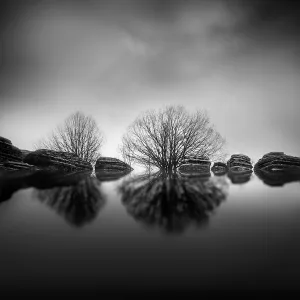
“Borders” collection
© Vassilis Tangoulis| Fine Art Photography
I experiment with light, time, and spatial coordinates– and then through my post processing, my “common” subject is finally framed in a transformed world in which its dimensions can be easily described and visualized. As you can see my intension is to question everything reality considers as prerequisite, to alter the way nature is photographed and finally to confuse the eyes of the viewer. Someone could say that this can be done easily if you use subjects like trees and rocks so i will give some more examples.
I always find as an interesting challenge to visit well photographed places like Meteora i visited lately. You can see my interpretation in one om my photos from my collection “Middle of the sky“. Emphasizing the tones of the misty backgound, playing with the tonal gradients, using dodging processing for the foreground rock formations and paying special attention to the light treatment managed to give a mystic atmosphere quite suitable , i think, to this special place. For a moment i manage to confuse the eye of the viewer about the reality of this landscape although all the elements of the frame seem to be quite real and if someone happens to be familiar with Meteora can raise easily the question if this photo was taken there.
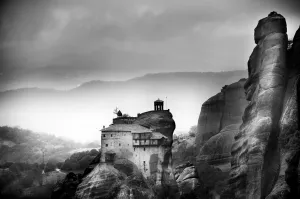
“Middle of the sky” collection
© Vassilis Tangoulis| Fine Art Photography
Finding…”Confusion”
I believe everything started unconsciously when I was trying to find my identity as a photographer many years ago. I never felt comfortable with street photography and landscape photography (when I was trying to capture the real picture of a scape). Then I discovered the neutral density filters and a whole new world was suddenly revealed. A world with blurred movements, skies with dramatic tones where the clouds have unreal shapes, the seas are frozen and everything there is blurred giving the notion of movement in a static medium.
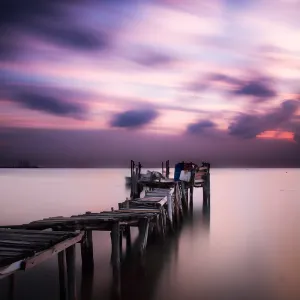
“Waterland” collection
© Vassilis Tangoulis|Fine Art Photography
The figures of people are abstract and in one picture there is a whole history of movements while colors, when the photograph is in color, have such a great mixture of tones already outside the classical pallet of colors nature uses to treat its miracles. I felt in love with this technique and the transformed world I could capture with my lens and by the same time this was my very first step to create confusion (not to me of course) but to all my viewers and to make them asking questions like (is this from a place in earth? Am I living in this place because I haven’t seen something like this before).
Elaborating Confusion through Clarity
Through the years i tried to elaborate my “Confusion” concept. I wanted to keep my photos simple. There is a misunderstanding here that simple means easy.
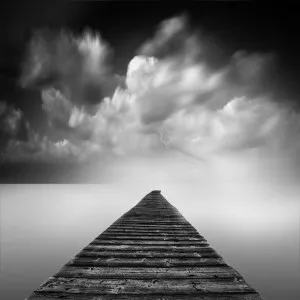
“Messolonghi” collection
© Vassilis Tangoulis|Fine Art Photography
Actually it is quite the opposite. Having a photo with a boat or a tree or an abandoned house “resting” in a large negative space is so challenging for me since I have to intrigue the eyes and the mind of the viewer and at the same time to make him/her wonder about the clarity of this work. In other words to confuse him/her about something so ordinary and simple. A large portion of my work is minimal having this kind of vision.I wanted to make this confusion more challenging and I think this next step was the decisive one since I managed to give my personal signature to this peculiar and at the same time so interesting perception of my “reality”. My intention was to produce photos with a “Clarity” character and this means that a viewer instantly and clearly understands my subject but at the same time a big question mark is revealed. The coexistence of these two contradictory feelings seems to be a mind game but actually for me is the only way to elaborate my vision and express my own feelings. How I succeed “Clarity and Confusion” in my photos? Mainly with my post processing workflow and ofcourse the choice of the frame. Always try to find the appropriate weather conditions when I shoot using the elements of mist, snow, rain, storms as a medium to create confusion. And ofcourse above all the power of long exposure photography.
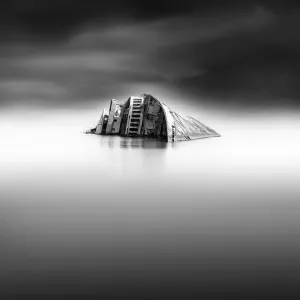
“Mediterranean sky” collection
© Vassilis Tangoulis|Fine Art Photography
In my collection Mediterranean sky my vision was to give a different view of a shipwreck playing again with the concept of “Clarity and Confusion”. After the first impression of a clear representation of a shipwreck I wanted to confuse the viewer. I wanted to give the impression that the half sank ship retrieves its other half and is ready to start its journey in a transformed world. I play the same mind game with almost all my collections where I usually present ordinary themes like trees, abandoned houses, animals, people and then I try to confuse and transform their identities and shape their “lives” in a different timeframe. In my “white silence” collection my vision was to confuse the viewer with the help of mist or snow and reveal the clarity of lonely trees in an unearthly and mystic environment
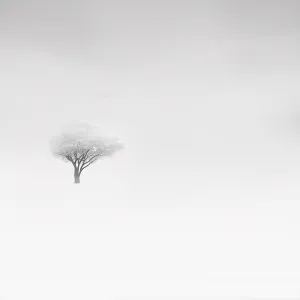
“White Silence” collection
© Vassilis Tangoulis| Fine Art Photography
Common mistakes and a tip
A very common mistake/confusion in the world of fine art photographers is that processing skills play the ultimate role in the quality of their work. I have to disagree with this point since the most important ingredient of a fine art photographer is the unique way of seeing the “reality”. This unique interpretation of ordinary things, the allegoric translation of common subjects is his real power. The processing skills can be tought, the “vision” depends on how “effectively” you transform your inner world to “pixel-like” codes and messages in your photograph. It is more like a confrontation with your inner world and Self Awareness processing. Another mistake strongly correlated with the lack of self-awareness is the imitation. Imitating the style of well-known artists does not make you good photographers but very good imitators. Are there any secrets or guidelines for this vision? I will share with you my own experience and hope this can be a useful guideline. Find inspiration from masters of Fine Art Photography and try to understand their motivations and their thoughts about Fine Art. Seek the power in their photography and try to understand why they fascinate you. Then reveal, explore, confront your inner world and work on how effectively you can “translate” your feelings and thoughts in your photographs. At this point you need to work also on your processing skills. That is all i can say since there is no any recipe for the vision just a personal struggle with your self and only.
I would like to close this post with my last example from my works showing reality and my vision. Finishing this introduction in my world of Fine Art Photography i hope i gave you an idea about my motivations and for sure will be a guide for my later posts about post processing. So stay tuned and thank you for your visit.
